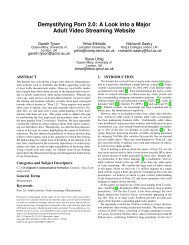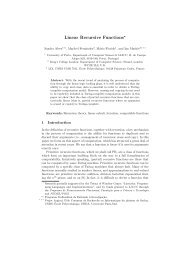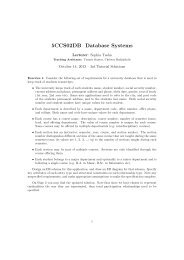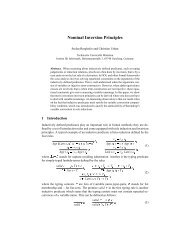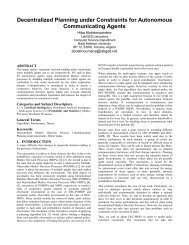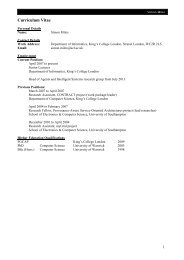Upgrade Report - Department of Informatics - King's College London
Upgrade Report - Department of Informatics - King's College London
Upgrade Report - Department of Informatics - King's College London
- No tags were found...
Create successful ePaper yourself
Turn your PDF publications into a flip-book with our unique Google optimized e-Paper software.
46Part VReferencesReferences[1] Dimitris Achlioptas, Aaron Clauset, David Kempe, and Cristopher Moore. On the bias <strong>of</strong> traceroutesampling: Or, power-law degree distributions in regular graphs. J. ACM, 56(4), 2009.[2] David Aldous and James Allen Fill. Reversible markov chains and random walkson graphs-chapter 9: A second look at general markov chains. http://statwww.berkeley.edu/pub/users/aldous/RWG/book.html,1995.[3] P. Gill B. Krishnamurthy and M. Arlitt. A few chirps about twitter. In Proceedings <strong>of</strong> the 1st ACMSIGCOMM Workshop on Social Networks, WOSN08, 2008.[4] Ricardo Baeza-yates, Carlos Castillo, Mauricio Marin, and Andrea Rodriguez. Crawling a country:Better strategies than breadth-first for web page ordering. In Proceedings <strong>of</strong> the 14th internationalconference on World Wide Web / Industrial and Practical Experience Track, pages 864–872. ACMPress, 2005.[5] A. Barabási and R. Albert. Emergence <strong>of</strong> scaling in random networks. In science, number 5439 inVolume 286, pages 509–512, 1999.[6] Vincent D Blondel, Jean-Loup Guillaume, Renaud Lambiotte, and Etienne Lefebvre. Fast unfolding<strong>of</strong> communities in large networks. Journal <strong>of</strong> Statistical Mechanics: Theory and Experiment,2008(10):P10008, 2008.[7] B. Bollobás and O. Riordan. Handbook <strong>of</strong> Graphs and Networks: Mathematical results on scale-freegraphs, pages 1–32. S. Bornholdt, H. Schuster (eds), Wiley-VCH, 2002.[8] Béla Bollobás, Oliver Riordan, Joel Spencer, and Gábor Tusnády. The degree sequence <strong>of</strong> a scalefreerandom graph process. random structures and algorithms. Random Structures and Algorithms,18:279–290, 2001.[9] Bélaa Bollobás and Oliver Riordan. The diameter <strong>of</strong> a scale-free random graph. Combinatorica, 24:5–34,January 2004.[10] Mickey Brautbar and Michael Kearns. Local algorithms for finding interesting individuals in largenetworks. In ICS, pages 188–199, 2010.[11] Andrei Broder, Ravi Kumar, Farzin Maghoul, Prabhakar Raghavan, Sridhar Rajagopalan, RaymieStata, Andrew Tomkins, and Janet Wiener. Graph structure in the web: experiments and models. InProceedings <strong>of</strong> the Ninth International World-Wide Web Conference (WWW9, Amsterdam, May 15 -19, 2000 - Best Paper). Foretec Seminars, Inc. (<strong>of</strong> CD-ROM), Reston, VA, 2000.[12] Meeyoung Cha, Hamed Haddadi, Fabricio Benevenuto, and Krishna P. Gummadi. Measuring UserInfluence in Twitter: The Million Follower Fallacy. In Proceedings <strong>of</strong> the 4th International AAAIConference on Weblogs and Social Media (ICWSM), Washington DC, USA, May 2010.[13] C. Cooper. The age specific degree distribution <strong>of</strong> web-graphs. Combinatorics Probability and Computing,15:637–661, 2006.[14] C. Cooper and A. Frieze. A general model <strong>of</strong> web graphs. In Science, 2001.[15] C. Cooper and A. Frieze. A general model web graphs. In Random Structures and Algorithms, pages311–335, 2003.[16] C. Cooper and A. Frieze. The cover time <strong>of</strong> the preferential attachment graphs. Journal <strong>of</strong> CombinatorialTheory, B(97):269–290, 2007.



